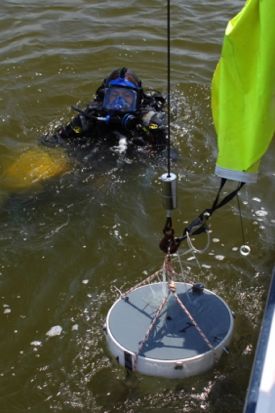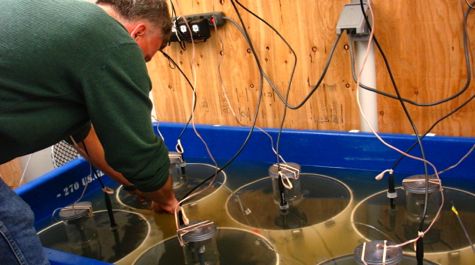Study shows restored oyster reef worth its weight in nutrients
Rates of nutrient removal among the highest ever recorded
A study led by researcher Lisa Kellogg of the Virginia Institute of Marine Science shows that a restored oyster reef can remove up to 10 times more nitrogen from Chesapeake Bay waters than an unrestored area nearby, providing additional evidence that reef restoration can contribute to efforts to improve water quality in the nation’s largest estuary.
The study, “Denitrification and nutrient assimilation on a restored oyster reef,” is the feature article in this month’s issue of Marine Ecology Progress Series. Co-authors are Jeff Cornwell, Michael Owens, and Ken Paynter of the University of Maryland Center for Environmental Science.
To date, the justification for restoring oysters to Chesapeake Bay has focused on their capacity to clear the water, provide habitat for their own young and for other species, and to sustain both watermen and seafood lovers.
The new study, says Kellogg, aimed to quantify another potential benefit of restored oyster reefs—their ability to remove nutrients from the water. Input of nitrogen and phosphorous from fertilizers, wastewater treatment plants, and other sources is one of the main reasons for impaired water quality in the Bay, with reduction and removal of these excess nutrients a key goal of Bay restoration efforts.
In Maryland’s Choptank River, the team compared a restored oyster reef that had 131 large oysters per square meter to an adjacent unrestored site that was suitable for restoration. They carefully measured flows of nitrogen and phosphorous compounds at each site, along with salinity, temperature, oxygen levels, sediment characteristics, and the abundance of oysters and other marine life such as mussels, clams, barnacles, and worms.
“Our study showed that a successfully restored oyster reef can remove significant levels of nutrients from the water column,” says Kellogg. “We found that annual denitrification rates at the restored site were enhanced by an order of magnitude and that rates in August were among the highest ever recorded for an aquatic system. It’s important to recognize, however, that the density of oysters on the reef we studied far exceeds current success criteria for oyster-reef restoration.”
Denitrification—the conversion of reactive nitrogen compounds back into the inert nitrogen gas that makes up most of our atmosphere—is a holy grail of restoration science. In its pure, gaseous form, nitrogen contributes little or nothing to the over-fertilization that plagues coastal waters worldwide.

Uptake into the tissues and shells of living organisms provides another way to remove nitrogen compounds from the water. The team’s research shows that the restored reef provided habitat for almost 25,000 bottom-dwelling organisms per square meter compared to just over 2,000 organisms per square meter at the control site. Nitrogen in shells of live oysters and mussels accounted for 47% of all nitrogen incorporated into living organisms at the site.
Kellogg says incorporation into shell is particularly important because “the shells of oysters and mussels can persist long after the organisms die, removing nutrients from the water for years, decades, or even centuries if the shells become buried.” Nutrients in soft tissues, on the other hand, can be quickly recycled back into the water, once again contributing to over-fertilization.
State and federal officials have used spat-on-shell and other methods to restore oyster reefs at more than 500 sites in Chesapeake Bay and Maryland and Virginia’s seaside bays during the last few decades. Although the high densities of oysters used in the study fall well within the range of historic oyster densities, these densities are rarely achieved today, due in part to the limited resources available for oyster-reef restoration. Kellogg says “The expense of oyster reef restoration, especially when hatchery-produced juvenile oysters are used, raises the question of whether its benefits are worth the investment. Our results add to the growing body of evidence suggesting that the benefits do outweigh the costs.”
Putting their findings into a management context, the team used their results from the Choptank reef to estimate the scale of oyster restoration needed to meet the EPA’s new nitrogen restrictions for this Chesapeake Bay tributary. “We estimate that more than 475,000 pounds of nitrogen need to be removed from the Choptank to meet current restrictions,” says Kellogg. “According to our calculations, this could be done by restoring high-density oyster reefs to 23% of the river’s available bottom.”
The researchers temper their conclusions by noting that additional work is needed to test whether their results from the Choptank apply equally to other parts of the Bay with different environmental conditions. They also stress that oyster reef restoration is not a substitute for reduction in land-based inputs, but rather a potential safety net to reduce additional downstream impacts. Most of the excess nitrogen in the Choptank River enters in low-salinity areas that do not support oyster growth, and will thus still have negative impacts upstream of restored oyster reefs.



